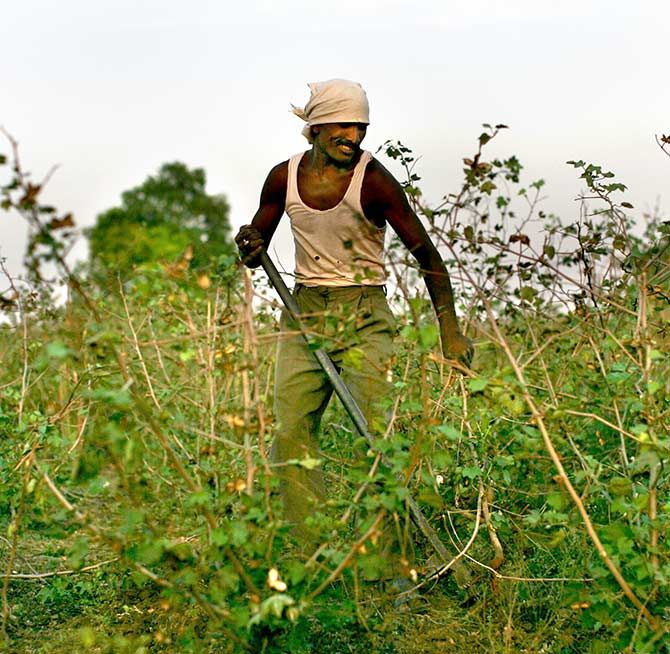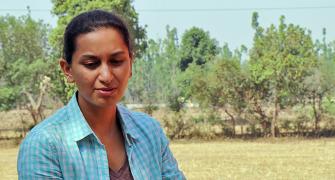Loan waivers will never be enough. Reforming the agricultural marketing system is essential to addressing the concerns of farmers in a sustainable manner, says Nitin Desai.

The farmers' agitation in Madhya Pradesh and several other states has raised concerns about the health of the agricultural sector.
It is worth noting that the farmers' agitation this year has come in the wake of a good monsoon in 2016.
That there is distress amongst farmers cannot be denied as is evident from the scale of the protests. But looking for immediate and longer-term responses requires a better understanding of the roots of the stress in the farming economy.
Over the past five years, the agricultural economy as measured by the gross value added (GVA) reported in the National Account Statistics has grown at an average rate of 2.3 per cent.
The index numbers of crop production show little or no growth since 2010-11. Hence, growth in GVA must reflect an improvement in the terms-of-trade for agriculture.
Though the average increase in minimum support prices (MSP) 2013-14 onwards was modest and about 4.1 per cent for rice and for wheat 4.8 per cent, the price increase for fertilisers, the main non-agricultural input into farming, from 2013-14 onwards averaged only 2 per cent. Thus, the terms-of-trade (the ratio of prices received to prices paid) improved from 98.8 in 2011-12 to 106.8 in 2015-16.
But though the terms-of-trade movement favoured agriculture, income may have shifted from farmers to agricultural labourers as a similar terms-of-trade calculation for farmers vis-à-vis non-farmers shows no such improvement and is static at 97 through these years.
This possibility is borne out by the data on agricultural wages, which doubled between 2010-11 and 2014-15. Hence, what we are facing is not just concerns about agricultural growth, but also about the distribution of income between landowners and labourers.
Farming in India is moving from a subsistence and traditional mode to a modern capitalist mode with farmers investing in land improvement and irrigation, adopting new seed varieties, new crops and new methods of cultivation.
Many farmers with marginal holdings are leasing their land to larger farmers so that there is a de facto dilution of ceiling laws.
Enterprising farmers are borrowing and investing in these improvements in a business where weather and market volatility risks have not been significantly reduced.
The key to weather risk lies in water management, and there the record of irrigation development is not inspiring. Surface irrigation is declining and the modest growth in irrigated area for quite some time has come from tube-wells set up by individual farmers which are leading to groundwater depletion problems in many areas.
Protecting farmers with crop insurance has started with some fanfare, but the coverage is still quite low and has crept up from 22 per cent of the sown area in 2013-14 to 26 per cent in 2015-16. Hence, the increasing recourse to loan waivers which, along with interest subsidies, complicates greatly the possibility of a commercially viable credit system for agriculture.
Resolving the supply side sources of uncertainty will take time and providing complete protection against weather uncertainties is not possible, particularly with the impending threat of climate change. It will become even more difficult with the reduction of plant biodiversity as commercial growers switch en masse to the latest high-yielding or high-value varieties.
But the risks linked to market uncertainties can be mitigated by policies and programmes that empower farmers individually or in groups.
The high levels of rice and wheat procurement and stocks held by the government sometimes creates the impression of an agricultural market dominated by the public sector, an impression reinforced by the tendency of our political masters to announce all manner of price objectives for products whose markets are outside their control.
The public procurement system is a substantial presence only in the markets for rice and wheat and that too in a limited number of states.
In the latest procurement season more than 93 per cent of wheat procurement took place in three states -- Punjab, Haryana and Madhya Pradesh.
In the case of rice, the spread was a little wider and 93 per cent of the procurement was spread over 10 states.
More than 60 per cent of the gross cropped area produces products others than rice and wheat, for most of which, even if minimum support prices (MSPs) are announced, hardly any procurement takes place. Farmers are entirely dependent on private traders.
A particularly important component of agriculture is the production of perishable fruits and vegetables and milk. For many of these products, markets are volatile with large differences in flush and lean season prices.
These products are an increasingly important component of consumer food demand and a major source of income for farmers. Fruits and vegetables are the dominant component of horticultural products, which account for about 30 per cent of the value of agricultural output.
Volatile potato and onion prices, and now with rising prosperity, tomatoes have always figured prominently in policy deliberations in Delhi. The focus is generally on inflation and the consumer interest dominates.
This year, the tables have turned. The problem is not inflation but deflation. (Reserve Bank of India and Monetary Policy Committee please note!)
Farmers of key perishables are facing a steady fall in prices for six months or more. The persistent decline in prices has been attributed to the impact of demonetisation on produce traders who operate with cash and who withdrew from the market.
Hence, for the first time in many years the CPI for food fell in the lean season month of May 2017. There is also a sharp difference in volatility between milk, a perishable with a more organised marketing chain and the other three perishables.
Reforming the agricultural marketing system is essential to respond to the fury of farmers.
Co-operatives of growers and linked investments in processing and cold chains, opening the doors for organised retail to deal directly with farmers, removing restrictions on how and to whom farmers can sell, all of them present in the case of milk marketing today, are a set of focused measures that can be implemented, provided the government is willing to take on the traditional traders who dominate the rural and urban markets for most perishables.









